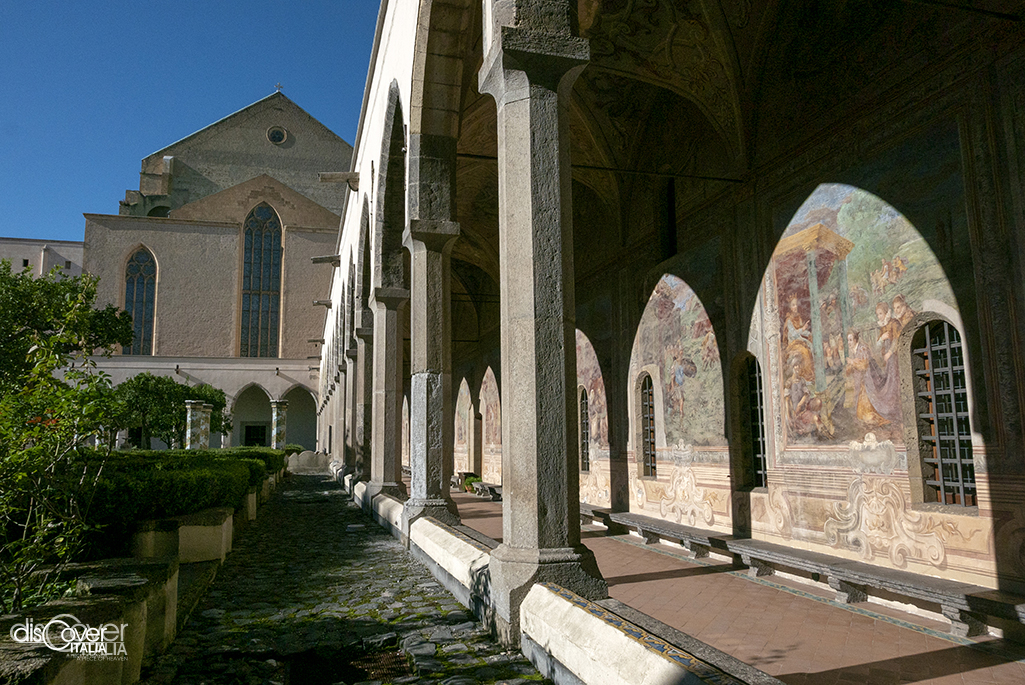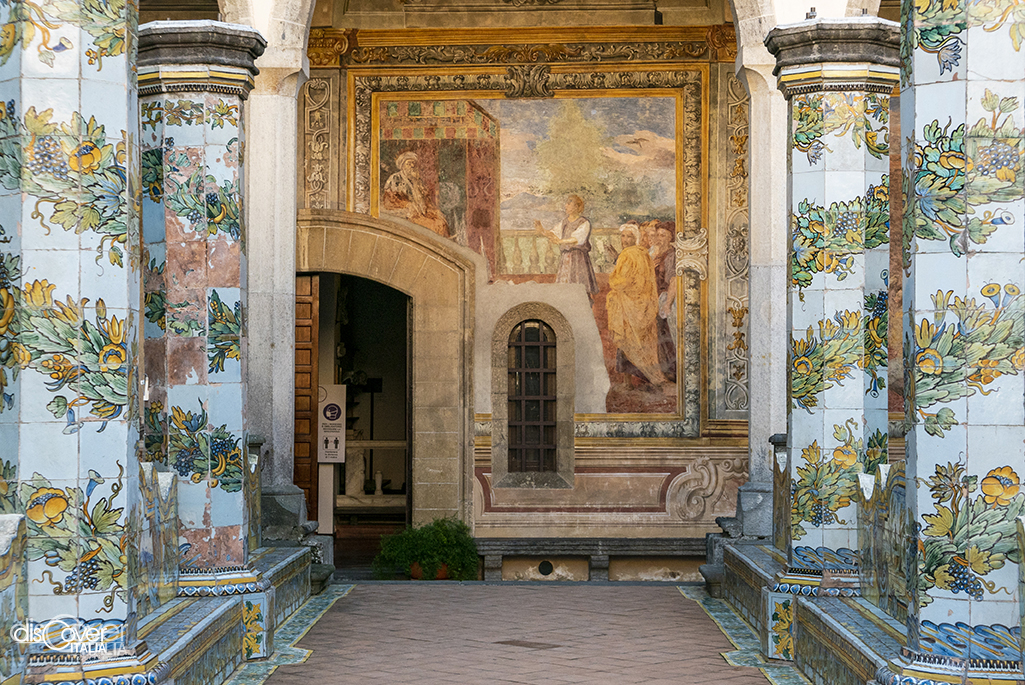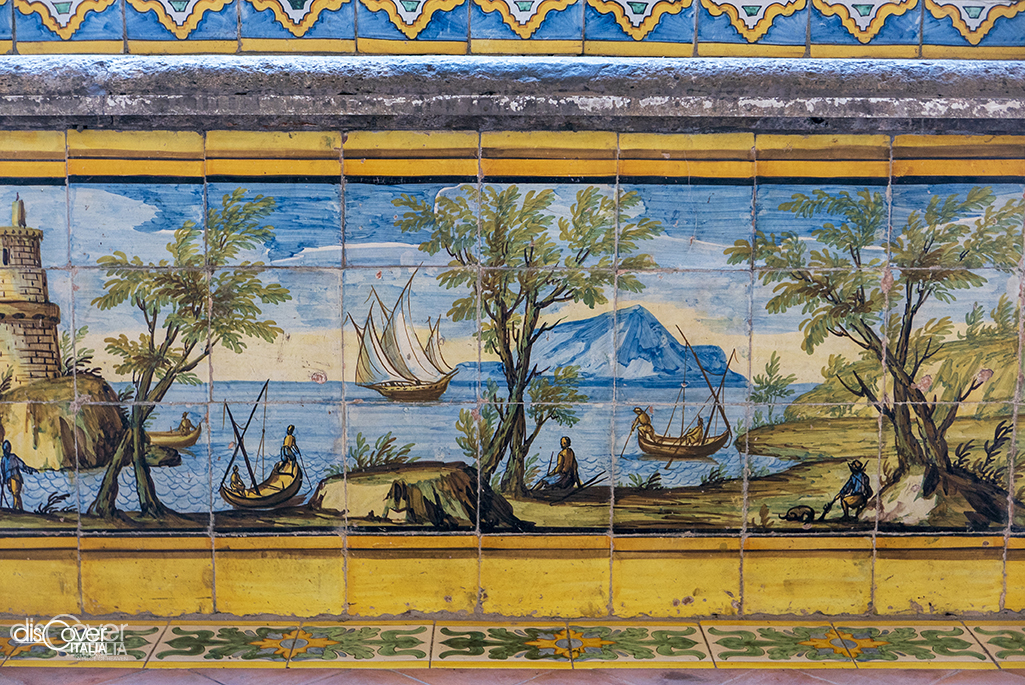Very religious, devoted to St. Francis like his second wife Sancha of Majorca, King Robert of Anjou wanted to create a Franciscan citadel just outside the ancient walls of his capital.
The works began in 1310 on a project by Gagliardo Primario and led to the creation of two monasteries, one female for the Poor Clares and one male for the Friars Minor (which later became the current church of the Poor Clares), a basilica dedicated to Santa Chiara with an imposing bell tower. The church, opened for worship in 1340, was intended to house the tombs of the royal family. The austere spire façade, with a large rose window and a pronaos with pointed arches, already reveals the Provençal Gothic style characteristic of the bell tower and the interior of the temple. This, with a single nave, 130 meters long, with ten chapels on each side, is suffused by a brightness that accompanies the gaze towards the presbytery, in the center of which towers the sepulcher of King Robert, the largest funeral monument of the Middle Ages, by Tino da Camaino. On the right side are the spectacular tombs of Charles of Calabria, the heir who died young, and of Maria di Valois, on the left the tomb of Maria di Durazzo by an anonymous known as the Maestro Durazzesco, while in the last chapel on the left are placed the tombs of the Bourbons.
 Behind the nave is the Nuns' Choir, one of the most important Gothic monuments in Naples, designed by Leonardo Di Vito with three naves, two of which are covered by cross vaults. The king commissioned the decoration to Giotto, who worked on it in 1328. Unfortunately, only the few fragments that survived the devastating bombing and subsequent fire that destroyed the basilica on 4 August 1943 remain. The event also decreed the disappearance of the Eighteenth-century transformations, according to the Baroque taste, made by Domenico Antonio Vaccaro between 1739 and 1742. The paintings by Sebastiano Conca, Giuseppe Bonito and Francesco De Mura also went up in smoke. The marble floor, on the other hand, was designed by Ferdinando Fuga. Immediately after the World War, the reconstruction of the church was started, according to a rigorous Gothic "version", under the direction of Mario Zampino and reopened to the public ten years later, on August 4, 1953.
Behind the nave is the Nuns' Choir, one of the most important Gothic monuments in Naples, designed by Leonardo Di Vito with three naves, two of which are covered by cross vaults. The king commissioned the decoration to Giotto, who worked on it in 1328. Unfortunately, only the few fragments that survived the devastating bombing and subsequent fire that destroyed the basilica on 4 August 1943 remain. The event also decreed the disappearance of the Eighteenth-century transformations, according to the Baroque taste, made by Domenico Antonio Vaccaro between 1739 and 1742. The paintings by Sebastiano Conca, Giuseppe Bonito and Francesco De Mura also went up in smoke. The marble floor, on the other hand, was designed by Ferdinando Fuga. Immediately after the World War, the reconstruction of the church was started, according to a rigorous Gothic "version", under the direction of Mario Zampino and reopened to the public ten years later, on August 4, 1953.
From the ancient choir, today the Adoration Chapel, which can only be visited by reservation, you can access the garden and the famous cloister, another jewel of the Santa Chiara complex.

The Cloister of wonders
The Cloister of Santa Chiara is a work of art in itself, spared from war destruction and celebrated for centuries. Commissioned by the abbess Suor Ippolita Carmignano, it was created by Domenico Antonio Vaccaro between 1739 and 1742, preserving the Fourteenth-century structure, but revolutionizing the garden with two perpendicular avenues, which form four distinct sectors: two are decorated with Italian hedges and fountains , the other two were dedicated to crops. The two avenues are flanked by 64 octagonal majolica pillars, connected to each other by artistic majolica seats, on which rural, marine and mythological scenes are depicted between vine shoots and, the only exception to the presence in a monastery, a nun who feeds kittens. The authors of the magnificent riggiole, painted with colors in perfect harmony with the lemon plantation of the flowerbeds, were the brothers Donato and Giuseppe Massa. The walls of the four sides of the cloister are entirely frescoed with depictions of saints and scenes from the Old Testament by an unknown artist from the early 1600s, perhaps a pupil of Belisario Corenzio.
The Museum of the Opera di Santa Chiara
On another level of the Fourteenth-century complex is the Museum of the Opera di Santa Chiara. Four rooms, which keep the ancient artistic and devotional jewels of the monastery spared from the bombs. The exhibition is inside and contiguous to the remains of a Roman thermal building from the end of the 1st century AD, of which the main rooms fed by the Serino aqueduct are still visible.

At the exit of the cloister, a valuable 17th-18th century Nativity scene is displayed, with a structure in papier-mâché, cork and wood, while the characters inspired by the nobles and commoners of the time have bodies in iron and tow and refined terracotta faces and hands.
Information
Monday through Saturday from 9:30 a.m. to 5 p.m. and Sunday from 10 a.m. to 2 p.m.
Full ticket: 6.00€
Reduced ticket: 4,50€





Comments powered by CComment